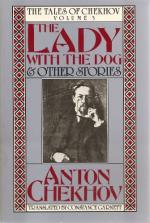|
This section contains 8,756 words (approx. 30 pages at 300 words per page) |

|
SOURCE: Martin, David. “Figurative Language and Concretism in Čechov's Short Stories.” Russian Literature 8, no. 2 (March 1980): 125–49.
In the following essay, Martin discusses Chekhov's use of figurative language, including comparison, simile, and metaphor, and how abstract-to-concrete similes give expression to the author's thematic and philosophic ideas.
1.
There are many ways in which Čechov introduces elements of the physical world into the treatment of abstract ideas or emotions in his short stories. Whilst frequently they relate to questions of environment or setting, of interest here also is his elucidation of abstractions, including the heroes' psychological attitudes and feelings, by means of comparisons drawn from the physical world. It is these comparisons which form the subject of the major part of this essay, which concerns itself exclusively with Čechov's use of figurative language in the general field of abstract and concrete.
Čechov's employment of abstract-to-concrete simile testifies to an overall tendency of...
|
This section contains 8,756 words (approx. 30 pages at 300 words per page) |

|


